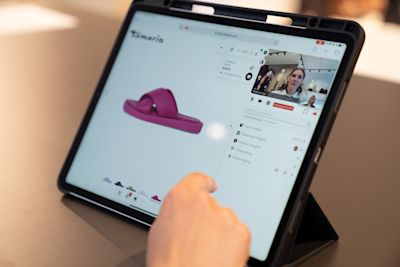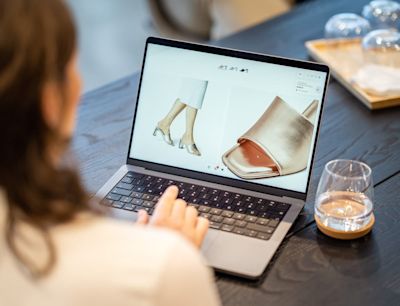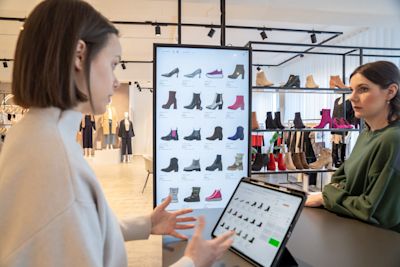
Wortmann Group, renowned globally for its diverse shoe brands like Tamaris, made history as the first Shopware customer to embrace the Digital Sales Rooms feature for their B2B online business. It's been about a year since our previous interview, where we delved into the implementation of Digital Sales Rooms. Today, we engage in another dialogue, reflecting on the past year to explore the evolution of their advanced experiences with Digital Sales Rooms.
Our very own Tiemo Nolte, Product Owner for Digital Sales Rooms, sat down with Michelle Pusdrowski, E-Commerce Specialist B2B at Tamaris. You can witness the key questions in the video and delve into the comprehensive version in the text interview.
Key questions in the video interview
Complete interview in written format
Please describe yourselves and your company. Who is behind Wortmann, and what does your business look like?
Michelle Pusdrowski: The Wortmann Group from Detmold, known primarily for its brand Tamaris, is one of the largest shoe production and distribution companies in Europe and is considered the market leader for fashionable women's shoes. The collections are sold in over 70 countries and more than 15,000 shoe stores worldwide. In addition to Tamaris, the group of companies includes the brands Marco Tozzi, Caprice, Jana, and s.Oliver shoes. The core of our business is the development, production, and distribution of shoes to shoe and fashion retailers.

A brief refresher: Please explain what Digital Sales Rooms is exactly.
Michelle Pusdrowski: Digital Sales Rooms is a module in Shopware that enables us to offer our B2B customers individual, hybrid, and interactive shopping experiences.
On the one hand, this includes digital offers that customers can browse independently. And on the other hand, digital appointments are created and held via Digital Sales Rooms, in which the respective salesperson guides their customers through a curated offer via the direct integration of a video conferencing tool.
It is important to emphasize that Digital Sales Rooms is based on the Shopware shop system and can therefore be used easily and flexibly. Offers and appointments are created and customized with the help of the shopping experiences already known from Shopware. Our customers get access to offers or appointments via a web link, have various interaction options, and can buy directly from the application.

How did you decide to introduce the Shopware 6 feature Digital Sales Rooms? What challenges did you face?
Michelle Pusdrowski: In addition to the classic challenges brought by the pandemic, such as the cancellation of physical sales appointments, we also had to deal with changing sales and retail structures. These led to an increase in the number of customers to be served per salesperson and customers having to travel further to visit showrooms. We needed a tool that would allow us to serve each customer and provide the best possible customer service.
Guidance was particularly important to us. We didn't just want to direct customers to the B2B shop, but to accompany and guide them through the collection – and to do so as personally as possible.
In addition, we wanted to find a holistic solution for digital support throughout our entire sales process.
With Shopware's Digital Sales Rooms module, we found a solution that allowed us to use the existing processes one-to-one and could thus be integrated into our company infrastructure in a simplified way. We therefore decided against a separate tool and chose to use the Shopware toolset.
Are the challenges still the same today? The pandemic is over, and traditional sales visits are possible again. How important is Digital Sales Rooms for you today?
Michelle Pusdrowski: Certainly, a large part of the customer appointments for the main collections take place physically again. However, there is still the challenge that customers cannot attend a physical collection presentation in person for various reasons. We notice this, especially with the launch of smaller in-season collections. Therefore, it is particularly important for us to be able to react flexibly to customer needs with the help of Digital Sales Rooms. And it is not only a tool for holding digital customer appointments, but also provides valuable support for the traditional customer appointment. In addition, Digital Sales Rooms helps with the preparation and follow-up of customer appointments as well as with the preparation of offers. The relevance has not decreased at all, and the Digital Sales Rooms module is still an important component in our holistic sales process.
For which use cases do you use Digital Sales Rooms specifically in your sales strategy?
Michelle Pusdrowski: We use Digital Sales Rooms to send offers to our customers. This includes one-page offers curated for the customer, but also digital lookbooks that contain entire collections. Especially in the second use case, the offers also serve as information for our internal employees.
Customers and representatives can also use the digital lookbooks, for example, to prepare for and/or follow up on physical customer appointments.
Digital Sales Rooms is also used for digital customer appointments, replacing video appointments via traditional video providers.
The technology also plays a major role in our hybrid showrooms. A pilot project is currently taking place in Hamburg.

What problems were you able to solve from a sales perspective with Digital Sales Rooms?
Michelle Pusdrowski: A very big advantage compared to the classic PDF offer is the actualization of Digital Sales Rooms offers. Since customers usually process offers with a time delay, orders were often rejected due to out-of-stock items or assortments, especially during periods of high stock rotation. In Digital Sales Rooms offers, the availability is updated automatically.
In addition, it is avoided that customers have outdated versions of, for example, digital lookbooks. Especially at the beginning of a sales period, items may be deleted or new color variations are added. Using Digital Sales Rooms, the sent offers can be updated at any time, and images can also be quickly exchanged using the replacement function.
When sending PDF files, a multitude of offer versions had to be created due to country- and customer-specific data. With Digital Sales Rooms, this effort is avoided because customer-specific data such as prices and language are automatically loaded via the customer's log-in.
The tool also offers significant visual added value – offers are emotionalized and upgraded via appealing visual content.
In contrast to appointments via conventional video providers, in which the samples were held up into the camera, all color variants are available via Digital Sales Rooms – and not just selected sample colors. In addition, high-quality images and videos ensure that the materials and the haptic of the shoe are more easily visible. This was often a challenge during the original video appointments, where problems occurred due to camera resolutions and/or different lighting conditions.
Another great added value is that the customer can interactively participate in the digital customer appointment, thus avoiding the often tiring presentation character.

Which features support you particularly well in customer appointments?
Michelle Pusdrowski: In a customer appointment via Digital Sales Rooms, not only is the customer guided, but also the guide, the sales representative. Since the guide has a different view than the customer, he or she can discreetly access any product information at any time. Cross-selling elements on the PDP also help to present themes and sell additional items.
It is also worth mentioning that the movement during the digital customer appointment is similar to the movement in the physical showroom. This means that customers can move independently on a page – like in a room – and discover the collection. As a guide, however, I can navigate customers to me at any time and highlight certain styles. The guide can also jump to the customer via a corresponding function.
In addition, the guide has access to the entire product portfolio at any time via so-called instant listings and can thus react quickly to individual customer needs and add items that were not originally included in the presentation.
Another feature with great added value is the functionality of the like list and the shopping basket. Through various presentation and clustering options, a style selection and/or shopping basket can be easily analyzed as desired.
You mentioned earlier that you now also have a showroom in Hamburg. What is behind that, and what does it have to do with Digital Sales Rooms?
Michelle Pusdrowski: In Hamburg, we are piloting our first hybrid showroom. Here, the physical ordering process is digitally supported and optimized in various phases (from the opening conversation to the style selection to the order finalization). To be precise, this means that we use various screens at different points in the showroom, on which we project the Digital Sales Rooms appointment. All functionalities that support us in the digital appointment can thus also be used in the physical appointment. For example, the presentation of color variations that are not physically available in the showroom via model photos and videos. By implementing a scan function, the desired articles can be quickly transferred to the screens. The presentation of thematically matching styles can also be visualized digitally via the cross-selling functions.
The desired styles can then be liked directly on the screens or added to the shopping cart so that there is no need to type in all the article numbers later. The article selection can then be analyzed, and the order finalized via the various clustering options.
The like list and the shopping basket are synchronized with the B2B shop so that the customer can also view the selection in the shop. Boundaries between the different physical and digital touchpoints are thus minimized.

What are the biggest added values that Digital Sales Rooms offers for you?
Michelle Pusdrowski: If I personally had to pick out two of the added values mentioned, then it would definitely be the possibility of updating sent offers and having the availabilities updated automatically. I also think the connection between offers, customer appointments (whether digital or hybrid) and the B2B shop is great. This way, we can offer our customers a holistic experience.
How does your sales team perceive the Digital Sales Rooms function? Last year, you spoke of a "change process." Where do you stand today, and what have you learned in dealing with the feature over the past year?
Michelle Pusdrowski: We are still in the middle of the change process. In recent months, we have focused on adapting Digital Sales Rooms to our internal processes. The main focus here was on the intuitive usage of the backend for our sales staff, so that, for example, individual offers can be created with just a few clicks.
The use of Digital Sales Rooms currently depends to a large extent on the customer structure and the technical affinity of the buyers. The tool is already regularly used in the key account management. But also in other areas, the desire for digital appointments is actively driven by the customer, for example, by canceling the physical appointment at short notice due to illness.
A greater challenge remains the hybrid showroom, where we integrate additional technology into a sales process that has been firmly established for many years. It is therefore particularly important that we use the new technology wisely so that it offers concrete added value for customers and sales staff.
And what about your customers? Was the introduction of Digital Sales Rooms also a change process for them? How is the tool accepted, and why?
Michelle Pusdrowski: The presentation of the listing and content pages is very similar to our B2B shop. And since the majority of our customers are already experienced with our shop, they quickly feel familiar with the application. We receive very positive feedback and can see that the customers enjoy the features. Especially when trying out the new touchscreen functions in the hybrid showroom.
However, there are also customers with less digital affinity. It is therefore important to emphasize that Digital Sales Rooms will not replace the physical order appointment.

What specific added value does Digital Sales Rooms offer for your customers?
Michelle Pusdrowski: The biggest added value is the increase in customer service. Digital Sales Rooms gives us the opportunity to serve all customers individually. Without the toolset, this was not possible in all situations.
Another added value is the increase in the quality of the offers. Thanks to the image quality, different angles, and videos at the foot, purchasing decisions can be made much better. The fact that the offers are always up-to-date is of course, also part of this.
In addition, viewed offers and presentations in which the customer has participated can be accessed afterwards via the B2B shop. In this way, information that has been communicated, such as trend topics, can be looked up again at any time.
The connections between the individual touchpoints and the associated flexible use of Digital Sales Rooms also offer important added value. For example, customers often have very little time on order days. The possibility of making an initial item selection in advance and then optimizing it in consultation with the representative during the customer appointment and then finalizing it at home, if necessary, means that time pressure during the appointment can be avoided.
That all sounds like a very successful implementation. But to be more specific: How successful are you in using Digital Sales Rooms?
Michelle Pusdrowski: Currently, the Digital Sales Rooms functions are being used in addition to the originally used tools. This phase of parallel operation was very important and right for us, as we recognized the need to optimize the tool to our internal sales structure during live operation. We were thus able to add important features. We can now complete this optimization phase in the near future and will then continue to focus on intensive training of the office staff and sales representatives. In the next sales phase, Digital Sales Rooms will become the main tool for creating offers and holding digital and hybrid customer appointments.
What can you recommend to other retailers facing similar challenges?
Michelle Pusdrowski: We can only recommend taking a holistic view of the customer journey and the associated touchpoints and thinking about how these can be supported digitally. With the clear goal in mind of increasing efficiency and making the processes more valuable. It is not always necessary to think from scratch. Digital possibilities are often already available out of the box. It is then a matter of recognizing the potential that could arise for the company through implementation.
Within the project, it was very helpful for us to involve the users of the tool in a regular exchange at an early stage. On the one hand, this increases the acceptance of new technologies and on the other hand, it helps to make the application as intuitive and useful as possible for the users.
Thank you for the open and insightful interview!

In collaboration with the Wortmann Group, we have developed a checklist designed to assist other companies in gauging their progress on the path to a digitalized sales strategy. Is Digital Sales Rooms the ideal move for you to gain a competitive edge?











